July 14th Scots Book of Days
 July 14 – 1410 Arnold, Duke of Guelders born. Arnold of Egmond (14 July 1410, Egmond-Binnen, North Holland – 23 February 1473, Grave) was Duke of Guelders, Count of Zutphen. Arnold was son of John II of Egmond and Maria van Arkel. Ancestor of Mary of Guelders, Queen to James 2nd Stewart King of Scots, and ancestress of all Scots monarchs since, and English monarchs since James 6th of Scotland and 1st of England, and some Miller since late 16th century, Simmons since 18th century, and Choate since late 19th century.
July 14 – 1410 Arnold, Duke of Guelders born. Arnold of Egmond (14 July 1410, Egmond-Binnen, North Holland – 23 February 1473, Grave) was Duke of Guelders, Count of Zutphen. Arnold was son of John II of Egmond and Maria van Arkel. Ancestor of Mary of Guelders, Queen to James 2nd Stewart King of Scots, and ancestress of all Scots monarchs since, and English monarchs since James 6th of Scotland and 1st of England, and some Miller since late 16th century, Simmons since 18th century, and Choate since late 19th century.
An artist whose name has been lost to time painted the gold-studded illuminations around 1440 in a book of prayers for Catherine of Cleves, a Dutch countess. Her court commissioned the volume of hours, or illustrated daily devotions, around the time she separated from her spendthrift husband, Arnold of Egmond, and began a futile 30-year effort to unseat him.
thingsthatquickentheheart.blogspot.com/2011/05/hours-of-catherine-of-cleves.html
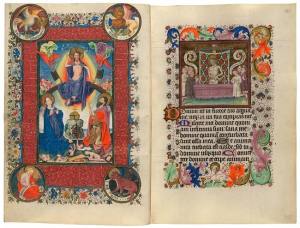 The Hours of Catherine of Cleves is the most important and lavish of all Dutch manuscripts. Browse the complete digital version
The Hours of Catherine of Cleves is the most important and lavish of all Dutch manuscripts. Browse the complete digital version
www.themorgan.org/collections/works/cleves/manuscriptEnlarge.asp?page=75
1437 Adolf, Duke of Jülich-Berg, died, son of William VII of Jülich, 1st Duke of Berg, and grandson of Gerhard VI of Jülich, Count of Berg and Ravensberg, brother of William’s father. Adolf, Duke of Jülich-Berg (c. 1370 – 14 July 1437), was the first Duke of duchies of Jülich and Berg. Adolf also began a year-long hereditary war against the House of Egmond for the dukedom of Guelders but could not win even with financial support from Sigismund, Holy Roman Emperor, who supported Adolf in this fight despite Adolf’s opposition to Sigismund’s coronation at Aachen in 1414. 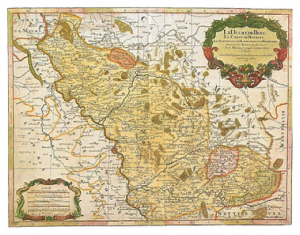 Adolf supported the Roman candidate in the Council of Constance which ended the Western Schism. He traditionally fought against the Archibishop of Cologne. He later secured Monschau-Montjoie and in 1428 he seized Lievandal-Wevelinghoven. Near kin to Mary of Guelders, Queen to James 2nd Stewart King of Scots, and ancestress of all Scots monarchs since and English monarchs since James 6th of Scotland and 1st of England.
Adolf supported the Roman candidate in the Council of Constance which ended the Western Schism. He traditionally fought against the Archibishop of Cologne. He later secured Monschau-Montjoie and in 1428 he seized Lievandal-Wevelinghoven. Near kin to Mary of Guelders, Queen to James 2nd Stewart King of Scots, and ancestress of all Scots monarchs since and English monarchs since James 6th of Scotland and 1st of England.
Map of Le Duchie Berg. In modern Dutch province of Gelderland. ArchyDuchie de Cologne on west, Coutye de la Marche on the north east, Westphalia.
1534 to 1607 to 1641. Religious persecution laws adopted at various times in these years. The Act of Uniformity, the Test Acts and Penal Laws of England, (with jurisdiction into Ireland, Scotland and British colonies of Africa, India, and Americas), enforced by execution and torture, fine and prison, confiscation and transport to the plantations (American colonies, if you weren’t already here) were, according to Edmund Burke “a machine of wise and elaborate contrivance, as well fitted for the oppression, impoverishment and degradation of a people, and the debasement in them of human nature itself, as ever proceeded from the perverted ingenuity of man.”  Savage, John (1869). Fenian Heroes and Martyrs. Patrick Donahoe. pp. 16. Bans on Catholics, Dissenters from the Established Church, (Nonconformists, Presbyterians, Lutherans, Quakers, Covenanters, Methodists (except when claiming Anglican status) Congregationalists, Jews, Anglicans 1650-1661, Baptists, along with slaves, felons, imbeciles. and foreigners) Ban on Catholics studying at Trinity College Dublin, Ireland, repealed by the Relief Act of 1793. Wikipedia. Penal Laws repealed 1829. The Long Room, Old Library, Trinity College Dublin hqworld.net Ireland is 20 miles from Scotland, across the north channel.
Savage, John (1869). Fenian Heroes and Martyrs. Patrick Donahoe. pp. 16. Bans on Catholics, Dissenters from the Established Church, (Nonconformists, Presbyterians, Lutherans, Quakers, Covenanters, Methodists (except when claiming Anglican status) Congregationalists, Jews, Anglicans 1650-1661, Baptists, along with slaves, felons, imbeciles. and foreigners) Ban on Catholics studying at Trinity College Dublin, Ireland, repealed by the Relief Act of 1793. Wikipedia. Penal Laws repealed 1829. The Long Room, Old Library, Trinity College Dublin hqworld.net Ireland is 20 miles from Scotland, across the north channel.
1572 sometime in July. RUTHVEN, WILLIAM, fourth Lord Ruthven and first Earl of Gowrie (1541?–1584), Provost and Lieutenant of Perth, defeated a sortie from Edinburgh Castle.
1648 Cavalry units from the Scottish Engager army, commanded by the Duke of Hamilton, clashed with Lambert’s Parliamentarian cavalry at Penrith. www.bbc.co.uk/scotland/history/onthisday/july/14
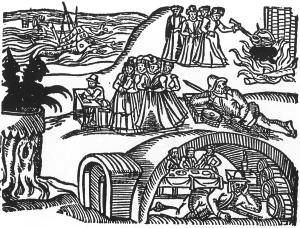 1649 sometime in July. Witchcraft. sister of Sir John Henderson of Fordel, and wife to Laird of Pittardo, in Fife. Notwithstanding her honourable birth and connexions, this unfortunate matron was, in the year 1649, imprisoned in the common jail of Edinburgh, from the month of July till the middle of the month of December 1649, when she was found dead, with every symptom of poison. (TG47-139).
1649 sometime in July. Witchcraft. sister of Sir John Henderson of Fordel, and wife to Laird of Pittardo, in Fife. Notwithstanding her honourable birth and connexions, this unfortunate matron was, in the year 1649, imprisoned in the common jail of Edinburgh, from the month of July till the middle of the month of December 1649, when she was found dead, with every symptom of poison. (TG47-139).
www.shc.ed.ac.uk/Research/witches/illustration.html This is a woodcut from the pamphlet Newes from Scotland, about the North Berwick witch-hunts of 1590-1. The author was probably James Carmichael, minister of Haddington, who helped to interrogate the North Berwick witches and who advised King James on the writing of his book Daemonologie. The pamphlet was published in London in 1591, and contains virtually the only contemporary illustrations of Scottish witchcraft. Centre and left: a group of female witches listen to the Devil preaching a sermon in North Berwick church at Hallowe’en 1590, with John Fian, schoolmaster of Haddington, acting as their clerk. The devil is pictured in black silouettee with either a bad hair day or horns, and long finger nails or claws, and a gottee. Top left: a ship is sunk by witchcraft. The witches were accused of raising the storms that troubled the voyage of James’s bride, Anne of Denmark, to Scotland, though in fact none of her ships were sunk. The pamphlet describes the sinking of a ferryboat in the Forth, and elsewhere in the trials some of the witches were accused of having sunk a ship, the Grace of God, at North Berwick. Top right: witches stirring a cauldron—a stock image rather than a scene directly from the pamphlet. (scene in MacBeth, Shakespeare, circa 1600)
1700 sometime in. Failed harvest, severe famine, 5-15 percent starved to death. The seven ill years was a period of national famine in Scotland in the 1690s, by four years of failed harvests (1695, 1696 and 1698–99). The period is named after the Biblical famine in Egypt predicted by Joseph ben Jacob in the Book of Genesis. The famines led to a rapid increase in the number of paupers and vagrants taking to the roads to find work, charity and food. In 1698, Andrew Fletcher of Saltoun (1655–1716) estimated that perhaps one-sixth of the population of Scotland, about 200,000 people, had left their homes to beg for food and charity, a doubling of the 100,000 vagrants that he estimated travelled the country during non-crisis years. Wikipedia.
1708 ‘This day Mr. Robert Millar [II of St. Quivox] student delivered his popular Sermon fromys 3 & 5 & was approbn by proff. Delagos.’ After further vivas, he was licensed, with Mr. Robert Wodrow acting as moderator, and his cousin Robert of Port Glasgow and his brother John of Neilston among those present. (Records of Paisley) 76 YYMAPresbytery, Register House, Edinburgh, Vol. II pp. 5-25)
1721 – John Douglas, Scottish Anglican bishop and man of letters (d. 1807).
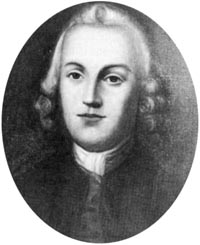 1779 George Ross died (May 10, 1730 – July 14, 1779) (clan Ross) was a signer of the United States Declaration of Independence as a representative of Pennsylvania. George Ross was born May 10, 1730 at New Castle Delaware. He was the oldest son in his family. His dad was an Anglican clergyman who had immigrated from Scotland
1779 George Ross died (May 10, 1730 – July 14, 1779) (clan Ross) was a signer of the United States Declaration of Independence as a representative of Pennsylvania. George Ross was born May 10, 1730 at New Castle Delaware. He was the oldest son in his family. His dad was an Anglican clergyman who had immigrated from Scotland
George Ross. 1873 oil painting by Philip Fishbourne Wharton after Benjamin West.
“I was also present [August 22, 23, 1877] in the St. George Temple and witnessed the appearance of the Spirits *** And also others,*** .Who came to Wilford Woodruff and demanded that their baptism and endowments be done. Wilford Woodruff was baptized for all of them. *** . They also prepared the peoples hearts so they would be ready to receive the restored gospel when the Lord sent it again to men on the earth.” (Personal journal of James Godson Bleak-Chief Recorder of the St. George Temple, Clerk to Brigham Young).
1789 Bastille Day In France is formally called La Fête Nationale (The National Celebration) and commonly le quatorze juillet (the fourteenth of July), commemorates the 1790 Fête de la Fédération. Scotland’s auld alliance with France (1200 to 1560) transferred with the Scots immigrants to America.
1789 – Alexander Mackenzie finally completes his journey to the mouth of the great river he hoped would take him to the Pacific, but which turns out to flow from Canada into the Arctic Ocean. Later named after him, the Mackenzie is the second-longest river system in North America.
 1820 John Gibson Lockhart, the Scottish biographer, was born. Son-in-law of the novelist, Sir Walter Scott, Lockhart himself was also a noted novelist, writing, among other works, Adam Blair, Walter Scott, Burns and Napoleon.
1820 John Gibson Lockhart, the Scottish biographer, was born. Son-in-law of the novelist, Sir Walter Scott, Lockhart himself was also a noted novelist, writing, among other works, Adam Blair, Walter Scott, Burns and Napoleon.
www.bbc.co.uk/scotland/history/onthisday/july/14
1856 Archibald Campbell died (1779 Glen Lyon, Perthshire, Scotland – July 14, 1856 Albany, New York) was an American politician who was Acting Secretary of State of New York from 1841 to 1842.
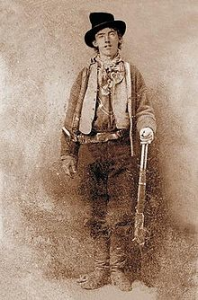 1881 – Billy the Kid (born William Henry McCarty, Jr.) is shot and killed by Pat Garrett outside Fort Sumner. William H. Bonney est. November 23,
1881 – Billy the Kid (born William Henry McCarty, Jr.) is shot and killed by Pat Garrett outside Fort Sumner. William H. Bonney est. November 23,
1859– c. July 14, 1881, also known as Henry Antrim, was a 19th-century American gunman who participated in the Lincoln County War, New Mexico territory.
Billy the Kid posing for a ferrotype photograph
1916 The 9th (Scottish) Division and took part in the Battle of the Somme in July 1916, and on 14 July the Battle of Delville Wood.
1919 allied victory parade Scottish National War Memorial.
1927 Scottish National War Memorial opens by Prince of Wales.
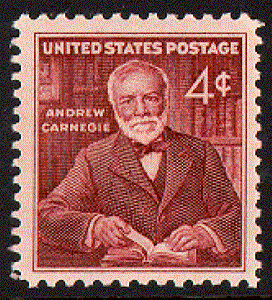 1923 the Hague Academy of International Law, an initiative of the Endowment, was formally opened in the Peace Palace at The Hague. The Peace Palace had been built by the Carnegie Foundation (Netherlands) in 1913 to house the Permanent Court of Arbitration and a library of international law. Carnegie was born in Dunfermline, Fife, Scotland.
1923 the Hague Academy of International Law, an initiative of the Endowment, was formally opened in the Peace Palace at The Hague. The Peace Palace had been built by the Carnegie Foundation (Netherlands) in 1913 to house the Permanent Court of Arbitration and a library of international law. Carnegie was born in Dunfermline, Fife, Scotland.
Andrew Carnegie settled in the Pittsburgh 4 cent.
1955 July to August. Joseph Fielding Smith, 10th President of the Church of Jesus Christ of Latter Day Saints. Descended from Mack of Inverness (clan Mack), Scotland and Malcolm King of Scots. Fills a special assignment in Asia, with Jessie accompanying him. Dedicates Guam, Korea, Okinawa, and the Philippines for the preaching of the gospel
1969 – The United States $500 William McKinley, $1,000 Grover Cleveland, $5,000 and $10,000 Salmon P. Chase (clan Ralston) bills are officially withdrawn from circulation.
1974 David James Stuart Mitchell (born 14 July 1974 ‘David Mitchell’ (actor). Mitchell’s ancestry from Highland Clearances. Son of Ian Douglas Mitchell and Kathy Grey Mitchell (née Hughes)
Disclaimer: The author of each article published on this web site owns his or her own words. The opinions, beliefs and viewpoints expressed by the various authors and forum participants on this site do not necessarily reflect the opinions, beliefs and viewpoints of Utah Standard News or official policies of the USN and may actually reflect positions that USN actively opposes. No claim in public domain or fair use. © John Choate
Utah Standard News depends on the support of readers like you.
Good Journalism requires time, expertise, passion and money. We know you appreciate the coverage here. Please help us to continue as an alternative news website by becoming a subscriber or making a donation. To learn more about our subscription options or make a donation, click here.
To Advertise on UtahStandardNews.com, please contact us at: ed@utahstandardnews.com.


Comments - No Responses to “July 14th Scots Book of Days”
Sure is empty down here...